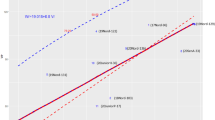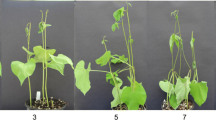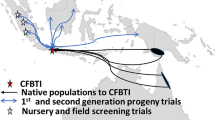Abstract
Ascochyta blight is a major fungal disease affecting chickpea production worldwide. The genetics of ascochyta blight resistance was studied in five 5 × 5 half-diallel cross sets involving seven genotypes of chickpea (ICC 3996, Almaz, Lasseter, Kaniva, 24B-Isoline, IG 9337 and Kimberley Large), three accessions of Cicer reticulatum (ILWC 118, ILWC 139 and ILWC 184) and one accession of C. echinospermum (ILWC 181) under field conditions. Both F1 and F2 generations were used in the diallel analysis. The disease was rated in the field using a 1–9 scale. Almaz, ICC 3996 and ILWC 118 were the most resistant (rated 3–4) and all other genotypes were susceptible (rated 6–9) to ascochyta blight. Estimates of genetic parameters, following Hayman’s method, showed significant additive and dominant gene actions. The analysis also revealed the involvement of both major and minor genes. Susceptibility was dominant over resistance to ascochyta blight. The recessive alleles were concentrated in the two resistant chickpea parents ICC 3996 and Almaz, and one C. reticulatum genotype ILWC 118. The wild Cicer accessions may have different major or minor resistant genes compared to the cultivated chickpea. High narrow-sense heritability (ranging from 82% to 86% for F1 generations, and 43% to 63% for F2 generations) indicates that additive gene effects were more important than non-additive gene effects in the inheritance of the trait and greater genetic gain can be achieved in the breeding of resistant chickpea cultivars by using carefully selected parental genotypes.



Similar content being viewed by others
References
Allard RW (1956) The analysis of genetic–environmental interactions by means of diallel crosses. Genetics 41:305–318
Collard B, Ades PK, Pang ECK, Brouwer JB, Taylor PWJ (2001) Prospecting for sources of resistance to ascochyta blight in wild Cicer species. Australas Plant Path 30:271–276
Collard BCY, Pang ECK, Ades PK, Taylor PWJ (2003a) Preliminary investigation of QTLs associated with seedling resistance to ascochyta blight from Cicer echinospermum, a wild relative of chickpea. Theor Appl Genet 107:719–729
Collard BCY, Pang ECK, Taylor PWJ (2003b) Selection of wild Cicer accessions for the generation of mapping populations segregating for resistance to ascochyta blight. Euphytica 130:1–9
Danehloueipour N, Yan G, Clarke HJ, Siddique KHM (2006) Successful stem cutting propagation of chickpea, its wild relatives and their interspecific hybrids. Aust J Exp Agric 46:1349–1354
Dey SK, Singh G (1993) Resistance to ascochyta blight in chickpea—genetic basis. Euphytica 68:147–153
FAO (2005) FAOSTAT DATABASE, FAO, Rome. http://faostat.fao.org/faostat/. Cited 20 March 2006
Flandez-Galves H, Ades PK, Ford R, Pang ECK, Taylor PWJ (2003) QTL analysis for ascochyta blight resistance in an intraspecific population of chickpea (Cicer arietinum L.). Theor Appl Genet 107:1257–1265
Gan YT, Siddique KHM, MacLeod WJ, Jayakumar P (2006) Management options for minimizing the damage by ascochyta blight (Ascochyta rabiei) in chickpea (Cicer arietinum L.). Field Crops Res 97:121–134
Hayman BI (1954) The theory and analysis of diallel crosses. Genetics 39:789–809
Hayward MD (1979) The application of the diallel cross to outbreeding crop species. Euphytica 28:729–737
Jinks JL (1954) The analysis of continuous variation in a diallel cross of Nicotiana rustica varieties. Genetics 39:767–788
Jinks JL (1956) The F2 and backcross generations from a set of diallel crosses. Heredity 10:1–30
Kusmenoglu I (1990) Ascochyta blight of chickpea: inheritance and relationship to seed size, morphological traits and isozyme variation. MSc thesis, Washington State University
Ladizinsky G, Adler A (1976). The origin of chickpea Cicer arietinum L. Euphytica 25:211–217
Lichtenzveig J, Shtienberg D, Zhang HB, Bonfil DJ, Abbo S (2002) Biometric analyses of the inheritance of resistance to Didymella rabiei in chickpea. Phytopathology 92:417–423
Mallikarjuna N (1999) Ovule and embryo culture to obtain hybrids from interspecific incompatible pollinations in chickpea. Euphytica 110:1–6
Mather K, Jinks JL (1982) Biometrical genetics. Methuen and Co Ltd, London
Millan T, Rubio J, Iruela M, Daly K, Cubero JI, Gil J (2003) Markers associated with ascochyta blight resistance in chickpea and their potential in marker-assisted selection. Field Crops Res 84:373–384
Nene YL, Sheila VK (1992) Important disease problems of kabuli chickpea. In Singh KB, Saxena MC (eds) Disease resistance breeding in chickpea. ICARDA Aleppo, Syria, pp. 11–22
Nguyen TT, Taylor PWJ, Redden RJ, Ford R (2005) Resistance to Ascochyta rabiei (Pass.) Lab. in a wild Cicer germplasm collection. Aust J Agric Res 45:1291–1296
Pande S, Siddique KHM, Kishore GK, Bayaa B, Gaur PM, Gowda CLL, Bertag TW, Crouch JH (2005) Ascochyta blight of chickpea (Cicer arietinum L.): a review of biology pathogenicity, and disease management. Aust J Agric Res 56:317–332
Reddy MV, Singh KB (1984) Evaluation of a world collection of chickpea germ plasm accessions for resistance to ascochyta blight. Plant Dis 68:900–901
Santra DK, Tekeoglu M, Ratnaparkhe M, Kaiser WJ, Muehlbauer FJ (2000) Identification and mapping of QTLs conferring resistance to ascochyta blight in chickpea. Crop Sci 40:1606–1612
Siddique KHM, Regan KL, Baker MJ (2004) New ascochyta blight resistant, high quality kabuli chickpea varieties for Australia. In: New directions for a diverse planet: Proceedings of the 4th International Crop Science Congress. Brisbane, Australia, 26 Sep–1 Oct 2004
Singh KB (1997) Chickpea (Cicer arietinum L.). Field Crops Res 53:161–170
Singh KB, Reddy MV (1983) Inheritance of resistance to ascochyta blight in chickpea. Crop Sci 23:9–10
Tekeoglu M, Santra DK, Kaiser WJ, Muehlbauer FJ (2000) Ascochyta blight resistance inheritance in three chickpea recombinant inbred line populations. Crop Sci 40:1251–1256
Tewari SK, Pandey MP (1986) Genetics of resistance to ascochyta blight in chickpea (Cicer arietinum L.). Euphytica 35:211–215
Udupa SM, Baum M (2003) Genetic dissection of pathotype-specific resistance to ascochyta blight disease in chickpea (Cicer arietinum L.) using microsatellite markers. Theor Appl Genet 106:1196–1202
Vir S, Grewal JS, Gupta VP (1975) Inheritance of resistance to ascochyta blight in chickpea. Euphytica 24:209–211
Acknowledgements
We thank Dr Tanveer Khan, Mr Alan Harris and Mr Stuart Morgan for their expertise and assistance in field screening for disease. We thank Dr Fucheng Shan for providing wild Cicer germplasm and Miss Leila Eshraghi for technical support. We are grateful to Dr Pooran Guar for critical comments on the manuscript. This project was partially funded by Ministry of Science, Research and Technology of Iran and CLIMA.
Author information
Authors and Affiliations
Corresponding author
Rights and permissions
About this article
Cite this article
Danehloueipour, N., Yan, G., Clarke, H.J. et al. Diallel analyses reveal the genetic control of resistance to ascochyta blight in diverse chickpea and wild Cicer species. Euphytica 154, 195–205 (2007). https://doi.org/10.1007/s10681-006-9287-0
Received:
Accepted:
Published:
Issue Date:
DOI: https://doi.org/10.1007/s10681-006-9287-0




